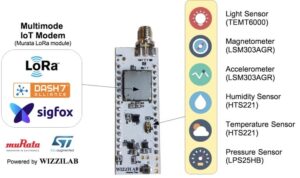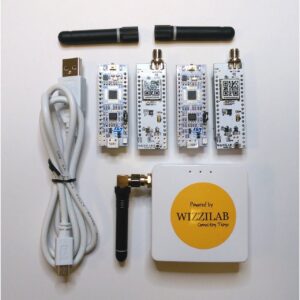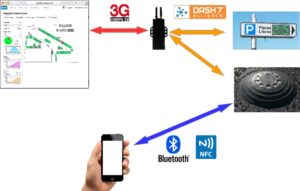
It’s one thing to understand that sub-gigahertz networks are the path to IoT (Internet of Things) but it’s another to know which road to tread and how to evaluate the present and future needs of an organization. Enter Wizzilab, a French company with a unique concept called WizziKit: an inexpensive multi-standard bundle designed to hasten developments thanks to a smarter way of approaching networking. WizziKit is composed of two Dash7 Nucleo Shields (SH2050), which integrate an STM32L0 microcontroller (MCU), and a plethora of ST MEMS-based sensors. There are also two Nucleo-L432KC development boards, which serve as a base for the SH2050. Finally, the GW2120 WizziGate acts as the access point connecting the network to the Internet.
DASH7: the “Secret” Weapon of Wizzilab
The choice of using DASH7 (D7A) sets Wizzilab apart from a lot of its competitors. The protocol operates in the 863–870 MHz (EU) or the 902–928 MHz (US) frequency bands. Hence, it covers a lot more ground than Bluetooth or Wi-Fi (up to 2 km) while using less energy than LoRa or SigFox (0,306 mJ for D7A vs. 810 mJ for Sigfox).
The open protocol comes from the ISO18000–7 standard for Active RFID, which explains why it is naturally instantaneous. Contrary to other RF protocols, connections are immediate. Furthermore, its bi-directional structure and secure framework (AES 128) mean it’s a great system to broadcast over-the-air (OTA) updates to all the nodes at once, which isn’t always evident or possible with the other sub-gigahertz standards. However, since devices will last for years, it’s imperative to ensure the propagation of patches in case of a bug or vulnerability. Finally, DASH7 can piggyback another physical layer (PHY), meaning that it’s possible to use a LoRa module, to get better range, while enjoying some of the advantages of DASH7 like its bi-directionality, structured data, security, etc. In customized products, WizziLab is even offering a multi-mode firmware stack covering D7A, D7A-LoRa, LoRa, and Sigfox, standards, ensuring both global IoT network connectivity and bi-directional access.
WizziKit: The Best Introduction to Sub-Gigahertz Networks

To learn more about this innovative way of approaching sub-gigahertz networks, we sat down with Yordan Tabakov, founder, and CTO of Wizzilab. He explained that WizziKit’s popularity stems from the fact that it is straightforward to put the bundle together to start showcasing the technology. Most companies just started grasping the new reality of sub-gigahertz networks, which often means that budgets are small and it’s crucial to impress the engineers or experts tasked to investigate the technology. After all, they are often the ones who will convince the executive and decision makers to heavily invest in a particular system. Hence, as Mr. Tabakov explained:
“ST enabled us to build something that remains simple, practical, and inexpensive. By using the ST platform, we can put together a kit and tools that ensure a quick setup and interesting demos that nicely show the impact of the technology on the company’s operations.The other and more recent feature of WizziKit that has proven extremely useful is the graphical user interface, which is so well designed that even people with very little knowledge of networks can understand what’s happening with the different nodes. After a few clicks, charts and graphs show how each element in the mesh relates to one another and how they communicate. There are even cloud services with open source JavaScript libraries to help developers build quick applications, and programming just requires the Mbed environment so they can more quickly convey what the technology will bring to the organization. The system even comes with application examples that draw from the ST Software Packs.
ST’s Flexibility Serving Wizzilab’s Creativity

Once customers have been awed by WizziKit and the features of D7A, Wizzilab will work with them toward customized solutions. This means that the company will design a specific firmware, optimize certain functions, and ensure that the final product can last for years on a single battery. After all, the point of a sub-gigahertz network is to cover a large area with a myriad of small terminals that offer absolute reliability and efficiency. However, the challenge with such a level of customization is that projects vary widely in their specification. This is also why Mr. Tabakov and his company chose the STM32 MCUs. As he told us:
“We found that the ST family of products can accommodate a really wide range of possibilities in terms of memory, power consumption, and pinout, to name a few. Furthermore, the interoperability between components, thanks to MCUs that are pin-to-pin compatibility for instance, makes it much easier to maintain Wizzilab’s different flavors of Hardware Abstraction Layers (HAL) while easily porting applications to each project.As a result, whether a product requires an MCU with a ton of Flash and hundreds of pins, or whether it is imperative to use a component that only contains a small memory and a handful of pins, it’s possible to work using the same environments and some of the same source code. Thanks to this, Wizzilab has been able to serve clients that have challenging use cases and require solutions outside of the mainstream application of the wireless technologies.
To learn more about Wizzilab, please visit their website.
